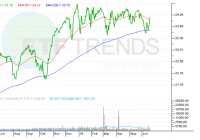2 Aristocrat ETFs
Summary Both NOBL and SDY replicate the S&P Dividend Aristocrats Index. A long-term investor might consider to possess a position in this type of ETF instead of purchasing dozens of different stocks. Here is a comparison between these two ETFs with high-quality holdings. Following my recent article regarding the SPDR Dividend ETF (NYSEARCA: SDY ), I have been asked whether SDY is also attractive when compared to the ProShares S&P 500 Dividend Aristocrats ETF (NYSEARCA: NOBL ). In order to compare between these two exchange-traded funds, I have added a third benchmark that represents the S&P 500 Index: the SPDR S&P 500 Trust ETF (NYSEARCA: SPY ). At first, I looked at the profile of the two ETFs that aim to follow the Dividend Aristocrats index. ETF Profile: Based on information from etfdb.com, it seems that in term of fees, both SDY and NOBL share the same expense ratio at 0.35% a year. SPY is cheaper, as it charges only 0.09%. Another observation is that the number of SDY’s holdings is double that of NOBL’s holdings. SDY is actually following the S&P High Yield Dividend Aristocrats Index, or “The Index of Champions”. This list includes more than 100 companies and can be found in David Fish’s CCC list . This is a composition of companies that increased their dividends in the last 25 consecutive years, including companies that had paid higher dividends in every calendar year. NOBL includes 53 holdings which follow the criterion of annual dividend increase for at least 25 years. The full list of Dividend Aristocrats can be found here . The difference in lists is demonstrated through both the top ten holdings and the sector-wise distribution of each ETF’s holdings: (click to enlarge) (click to enlarge) While NOBL holdings are leaning towards Consumer Defensive and Industrial sectors with companies like The Procter & Gamble Company (NYSE: PG ), Johnson & Johnson (NYSE: JNJ ) and Pentair Inc. (NYSE: PNR ), SDY is almost equally invested in Consumer Defensive, Industrials as well as Financial Services and REITs. Companies like Federal Realty Investment Trust (NYSE: FRT ), National Retail Properties, Inc. (NYSE: NNN ) and 1st Source Corporation (NASDAQ: SRCE ) are captured in SDY and not in NOBL. That is the reason why SDY can provide a higher dividend yield. ETF Performance: When comparing the performance of SDY, NOBL and SPY, we can see that since January 2014 until September 2015, NOBL actually did very well. In the recent sell-off, it actually dropped the least compared to the other two ETFs. NOBL ETF was established in late 2013, so it does not possess a historical performance track record. SDY’s return is lower on both the 3-year returns as well as the 5-year returns compared to SPY, as it is heavily tending towards Value holdings, while SPY’s holdings includes Growth companies. ETF Volatility: When comparing the volatility of these three ETFs, based on the Coefficient of Variation metric (Standard deviation divided by Average price), it was SDY which demonstrated the lowest volatility in the long run (0.035), while NOBL demonstrated lower volatility throughout the recent sell-off (0.023). ETF Payout: Both NOBL and SDY are trying to follow an index of dividend-paying stocks. NOBL has a short payout history, and therefore, by using the 2014 payout levels, which was 80c per share, the dividend yield in 2015 should be ~1.74%. If extrapolating the distribution that was paid in the first half of 2015, the dividend yield is expected to be closer to 2%. So, NOBL’s dividend rate is ~2%. SDY usually pays an extra payout in the last quarter of a calendar year. Using at the distribution levels of $3.74 per share in 2014, the yield is very close to 4%. Using the first half of 2015 as a proxy for the second half of the year, the yield is 2.5%. In either case, it is clear that the higher diversity that SDY holds allows the ETF to pay higher dividend yield to its shareholders. Conclusions: Both SDY and NOBL are ETFs that replicate indexes of top quality. NOBL’s core holdings are the top 50 Dividend Aristocrats, while SDY’s holdings list is broader. The broader list allows SDY to pay higher dividend, but it holds slightly higher risk. For investors who seek dividend income, SDY is the way to go. For investors who seek high quality with low volatility, NOBL is the way to go. For investors who are willing to take higher risk, care less about the dividend for higher return in the long run, SPY is the way to go. I am currently in favor of SDY due to its payout. Disclosure: I/we have no positions in any stocks mentioned, and no plans to initiate any positions within the next 72 hours. (More…) I wrote this article myself, and it expresses my own opinions. I am not receiving compensation for it (other than from Seeking Alpha). I have no business relationship with any company whose stock is mentioned in this article. Additional disclosure: The opinions of the author are not recommendations to either buy or sell any security. Please do your own research prior to making any investment decision.
